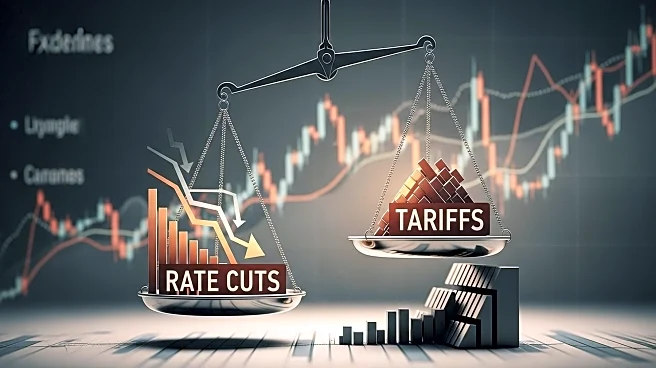What's Happening?
The Federal Reserve has reduced interest rates by 25 basis points to a range of 4.00-4.25% in response to ongoing inflationary pressures, with the Consumer Price Index (CPI) showing a year-over-year increase of 2.9% as of August. This move is part of a broader strategy to manage economic growth and inflation, although concerns remain about persistent high prices driven by tariffs. The stock market has reacted with mixed results; while the S&P 500 has risen by approximately 13% in 2025, strategists caution that valuations are high. Additionally, recent tariff announcements have influenced specific sectors, with companies like Paccar and Eli Lilly experiencing stock gains. In corporate news, significant mergers and acquisitions are underway, including a notable $85 billion merger between Union Pacific and Norfolk Southern, and a $4.2 billion real estate deal between Compass and Anywhere.
Why It's Important?
The Federal Reserve's decision to cut rates is significant as it aims to stimulate economic activity by lowering borrowing costs, which can encourage investment and spending. However, the persistent inflation and high valuations in the stock market pose risks of economic instability. The ongoing tariff impacts and new trade agreements, such as the U.S.-EU auto trade pact, are reshaping market dynamics, affecting consumer prices and corporate strategies. The mergers and acquisitions wave, highlighted by major deals in the rail and real estate sectors, suggests a trend towards industry consolidation, potentially leading to increased market power for large corporations. These developments have broad implications for investors, businesses, and consumers, influencing market confidence and economic forecasts.
What's Next?
Looking ahead, the Federal Reserve is expected to continue monitoring inflation and economic growth closely, with further rate cuts possible if inflation remains above target. The outcome of ongoing mergers and acquisitions will depend on regulatory approvals, which could shape the competitive landscape in various industries. Market participants will also be watching for any unexpected inflation surges or geopolitical developments that could disrupt the current economic trajectory. Additionally, the upcoming earnings season will be critical in assessing corporate health and market resilience amid these economic shifts.
Beyond the Headlines
The Federal Reserve's actions and the current economic environment highlight the delicate balance between stimulating growth and controlling inflation. The potential for further rate cuts underscores the challenges faced by policymakers in navigating economic uncertainties. The consolidation trend in industries like rail and real estate raises questions about market competition and consumer choice. Moreover, the impact of tariffs and trade agreements on global supply chains and pricing structures continues to be a critical area of focus, with potential long-term implications for international trade relations and economic stability.











